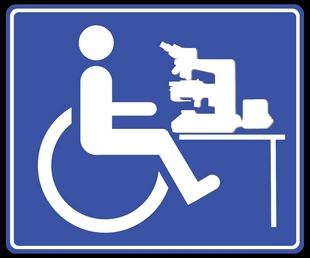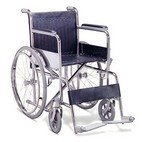User Repair - Number 2 (When necessity drives action)
Having finished a day's work outside in the yard, I entered the quiet of my home. Click...click...click...click,,, What the heck is that? I get off the Quantum 6000 powerchair I am currently using and examine the lower right chassis from where the sounds seems to emanate. There between the right tire and chassis I see a dangling spring --- one end connected, one end not. Something is broken.
Checking the mirror-image left side, I see that the front of the spring on that side is attached to the pivot-point on the rear of the caster arm. (Think of it as the elbow which bends up and down allowing your caster to bounce up or down over obstacles.) The back of the same spring appears to be attached to a rod-like structure which drops down (from where?) and the bottom has a loop through which a tensioning-bolt protrudes.
It appears that by tightening the nut on the tensioning bolt, you can add or release pressure on the spring. But for what purpose? The front attachment point of the spring is fixed (doesn't move). I cannot get down to floor-level to better examine the rod through which the tensioning bolt protrudes so I can't tell what it is attached to or if/how much it moves. I would think it would have to move back and forth - otherwise why would a spring be necessary? (if two fixed points there would be no need for the spring any more than driving two nails into a board and stretching a spring between them --- to what purpose?) I cannot physically reach the rear attachment point to tug on it to see if it moves. My wife was commandeered for the task which left me no further informed.
I downloaded a Quantum 6000 manual and though they have a couple of 'exploded' diagrams, none show the spring assembly in question. Short of my jacking the wheelchair up from the floor and removing the tire, I cannot determine the function of this spring/tensioning assembly.
Repair Shop
So I unhook the dangling broken spring and remove the bolt from the rear attachment point. It is obvious that one hook-loop has broken off of the spring. I take the parts and head down to the only wheelchair repair shop in the city, I show the parts to the receptionist who disappears into the bowels of the service department. After a short while she re-emerges to tell me that all the field-service technicians are out on appointments but that a parts-person said they do not have that item in stock. I was told I could make an appointment for a house call or one to bring the chair in for servicing.
"How long is your waiting-list for appointments I ask" for the last time I needed service (see broken caster-bearing replacement), I was told two-weeks. That was unacceptable! Well, it the situation has not much improved. The only other wheelchair repair franchise (Shopper's Home Healthcare) divested themselves of powerchair sales and service. Now my service provider has acquired many of their clients, yet qualified wheelchair technicians remain in short supply.
The question is "what is the function of this tensioning-assembly and will I damage anything by driving without it" as the powerchair seems to drive as before the assembly broke. I'm given no answers.
The Repair
So I go back to my home shop and root around to find a spring of somewhat the same size and tensile strength. I find one but it is about an inch too long. Below is my home-made replacement for the assembly in question.
Theoretically you would hook the front hook (4) through the hole on the rear of the front caster, then stretch the spring and push the bolt through the hole in the rear attachment arm. Once through you would thread the nut onto the bolt and tighten appropriately. (whatever that is)
I said "theoretically" as in practice my wife helper and I found that my spring (as did the original one) have so much tension that it probably could not be stretched by any one person and would require mechanical assistance. The bolt was only about a quarter of an inch too short to reach the rear mounting arm hole where the nut and ratchet nut driver would do the work stretching. Technicians must have some sort of jig to do this work for them, I have no way of knowing what tension had to be applied or if it is critical. As both the original spring and my newly made spring seemed to exhibit identical strong tension (elasticity), I simply tried to match the size of spaces between coils of the original spring (left side) to my replacement spring (right side)
My solution was to replace the bolt (2) with an eye-bolt that had a longer shaft. With the bolt shaft through the rear mounting arm hole, the nut was tightened with the ratchet driver. Sorry, I failed to take a photo of this but it was an eye-bolt similar to the one below.
Of course, once finished I find myself in our neighbourhood auto/mechanical parts store and find the perfect spring replacement in both size and tension. Still there are no open hooks on either end but could be easily modified with a hacksaw or other metal-cutting tool. (arrows)
I wonder what the parts and labour would have cost at my service provider had they been available?
Ah, what desperation will drive one to do!
* * *







.jpg)













